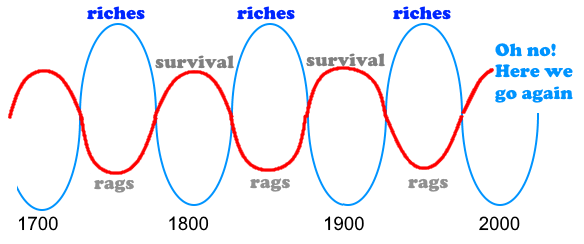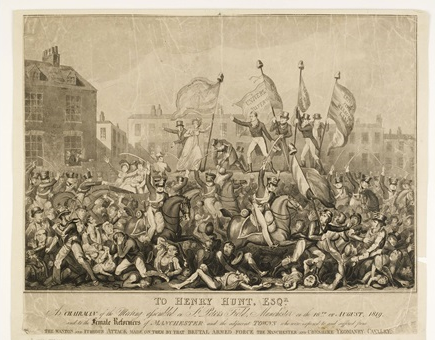The inevitability of hegemonic cycles - realty of myth?
Part 1
Hector McNeill1
SEEL
This article was first posted on CybaCity.com by Agence Presse Européenne correspondent's Pool workshop on "Essentials" reviewed why hegemonic cycles roll the way they do, ending up in speculative finance; our current state of affairs.
An analysis was presented that explored the question, "Is it possible to maintain the equilibrium between onshore employment, production and wage levels throughout a cycle?" This has always proven to be impossible and the outcome has significant implications for any post-Covid-19 economic policies. Investing in "infrastructure" and "building back better" seem to be empty rhetoric because conventional economic theory contains nothing to support this as a viable proposition.
This article covers the morning workshop session presentations (10th April, 2021). The afternoon session will be covered in a subsequent article.
|
Hegemon: a leader, country, or group that is very strong and powerful and therefore able to control others: |
|
|
BackgroundThe general characteristics of hegemonic cycles are a development of production processes, usually based on manufacturing, increasing productivity, expansion through exports, accumulation of money, investment offshore to raise profits by making use of lower cost offshore natural resources and labour, accumulation of money and the development of finance as the core activity and a financial speculation leading to collapse as other centres or countries initiate processes applying a different but competitive technology and the cycle starts over again with the country developing the new processes becoming the new hegemon.

There is much written on this topic and recognizable hegemonic cycles have involved, the Venetians, the Dutch, Spain, Portugal, Britain and more recently USA, now in decline, as China rises as the likely next hegemon.
Social historians and many economists see this cycle as an inevitable repetitive historic phenomenon because such cycles can be traced on the basis of a considerable amount of relatively indisputable evidence.
Historically, these cycles have occurred as a result of a particular form of decision making which lay in the hands of merchants and traders and some manufacturers whose financial status placed them in good stead with respect to the political leadership of their country. Dictators, sovereigns and certain types of government have relied on such entities to achieved certain ends such as military campaigns, or under colonialism to pay the national leaders or treasuries a share of commercial proceedings in colonies through grants or even taxation levied on colonists.
The motivation of productive and service sectors in pursuing their changing roles during hegemonic cycles was the single objective of increasing the wealth of those who had possession or title over the production or financial service activity resources. A marked characteristic of hegemonic cycles has been a separation of onshore populations in the hegemon into asset holders and those with command over production and financial services, on the one hand, and the general population of mainly wage earners, on the other. Over cycles the wealth and income of asset holder tends to increase while the real incomes of the majority of the population rose to some extent but always at a distinct disadvantage when compared with asset holder incomes. The majority of the population is made up of individuals and services groups who earn income on the basis of wages and or fees and most of these activities are linked to the distribution of goods and utilities such as food, water, energy, clothes, housing and transport. Wage earners include manual labour, manufacturing workforces, managers, financial and insurance service companies and bank employees, security and military services, politicians, medical practitioners and staff, police, educators, teachers, university professors, consultants, accountants, auditors, writers, artists and judges.
Thomas Robert Malthus (1766-1834)
 |
Thomas Robert Malthus was born in 1766 near what is now Guildford and he died in Bath in 1834. He studied at Jesus College Cambridge taking classics but concentrating on maths. He was the first professor of political economy in England.
He is well known for his analysis of the relative balance between natural resources and population growth. In particular he pointed out the difference in an arithmetic growth of for food production and a potential for human population numbers to increase exponentially. In mathematical terms this indicates that population can outstrip food supplies. Malthus only explained this difference but did not make any particular predictions. His most important observations related to the relationship between scarcity of resources such as food and the impacts and social consequences on the poor in England at the time of his analysis and writing
His theories on population and food supplies have been criticised for many years as the world appears to support an increasing population. However, although "economic development" continues, in real terms the numbers of people who approach the margin where famine can occur within a short time frame, seem to be increasing. In the end population size, along with environmental degradation, needs to move from the realms of political party identities, international resolutions and talk to relevant practical actions. |
|
|
One of the common onshore occurrences associated with the tail ends of hegemonic cycles has been the inflation reflected in the declining purchasing power of wages (income) associated with excessive injections of finance. This problem was studied in some detail by Robert Malthus, whose book on population,
"An Essay on the Principles of Population" was first completed in 1798 and underwent 6 editions in total with the last published in 1826.
This work is more relevant today than is commonly supposed. Malthus was concerned with explaining why the lower income segments in the United Kingdom where those who paid the price of increasing population size in terms of facing the threat of destitution as a result of falls in their real incomes and inability to purchase basic food items. Although, indeed, Malthus concentrated on a population dynamics model, he was fully aware of the impact of economic policy on inflation and he traced how this impacted the lowest income segments. Therefore Malthus was not only concerned with explaining the interaction between population growth and nature's human population carrying capacity. He also pointed out the specific impact of rises in prices in exacerbating the situation of the poor.
Malthus was at pains to increment each edition of his book with content that took into account criticisms and the controversy surrounding its contents. It is regrettable that the controversies over the population aspects of his work dominated the contentious arguments which influenced decision-makers and set in train political outlooks that are with us today. At least his ability to raise this issue as something of importance resulted in the UK establishing a population census in 1801 which has been carried out very ten years ever since.
Then it was the 5%, now 1%
A handbill announcing a gathering to protest conditions...in 1816  |
|
|
Unfortunately Malthus became more associated with his population work than his economic analysis which should have received more attention. However, although the first edition was published over 220 years ago, his general explanations remain of relevance to the situations in low income countries striving for economic development as well as, paradoxically, conditions in high income countries where the question of macroeconomic policies can be seen to have the same impact on lower income segments.
An important point in modern day discussions on Malthus is that he did not set out to predict that humans faced an inevitable catastrophe. His work was more directed at an evolutionary social theory of population dynamics to explain some of the contemporary political events and the relevant economic policy questions in England. These include the state of affairs of wage earners that led to the Peterloo Massacre.
The Peterloo MassacreThe government in Britain had regulated the prices of grain through Corn Laws initiated in 1815. At the end of the Napoleonic Wars that year, Parliament passed legislation banning the import of foreign corn into Britain until domestic corn cost 80 shillings per quarter. Malthus printed and released a pamphlet to be circulated during the parliamentary discussion. In this pamphlet he tentatively supported the free-traders. He argued that given the increasing cost of growing British corn, advantages accrued from supplementing it from cheaper foreign sources. Certainly the high price of corn resulting from the government-imposed import tariffs, caused the cost of food to increase and caused distress among the low income workers in the urban centres. This led to serious rioting in London and to the Peterloo Massacre in Manchester in 1819.
In August 1819 around 10-20 peaceful protestors were killed and hundreds injured by the military at what became known as the Peterloo Massacre. Around 100,000 people attended the meeting at St Peter's Fields in Manchester made up of local men, women and children and others who came from towns and villages across the North West, some walking nearly 30 miles to attend.

Print of the Peterloo Massacre depicting Female Reformers dressed in white and holding a banner for the Manchester Female Reform Union |
|
|
Although several members of the crowd attended from mere curiosity, most were supporters of parliamentary reform and had come especially to see the main speaker, Henry Hunt, known as 'Orator' Hunt because of his talent for public speaking.
Since the end of the Napoleonic wars in 1815, increasing numbers worked in industries but remained disenfranchised and they became involved in the movement for reform. Under the influence of men like Henry Hunt and the journalist William Cobbett, they began to campaign for universal suffrage. Their precarious state of affairs related to low real incomes caused them to argue that by extending the vote to working men would lead to better use of public money, fairer taxes and an end to restrictions on trade which damaged industry and caused unemployment and destitution. An important issue was tariffs on imported food which caused inflation and the inability of workers to purchase sufficient food for their families. Some campaigned for women to have the vote women in and around Manchester had begun to form their own reform societies campaigning on behalf of their male relatives and vowing to bring up their children as good reformers.
It is important to acknowledge that many of the modern day criticisms arise from a failure to appreciate that Malthus was addressing the drastic conditions facing the poor in England at that time. These led to food riots and eventually in a ruthless military intervention in peaceful protests. In recent years, as a result of inappropriate macroeconomic policies and in particular monetary policy, the poor in the United Kingdom are again facing the same problem of a drastic decline in real incomes and the need to resort to food banks (voluntary agencies that collect and distribute free food).
What has this got to do with hegemonic cycles?The period referred to by Malthus was a period when the British economy was transitioning from a mainly agricultural to a manufacturing economy, soon to accelerate with the establishment of the railway boom in the mid-1830s. Land owners wished to impose higher prices on a population facing falling real wages while "globalization" offered the means to lower the cost of food and thereby ameliorate the conditions of the poor. Malthus recognised the importance of food imports from offshore locations in helping reduce high prices for food or inflation, caused by comparatively inefficient onshore production.
 Jean Baptiste Say Jean Baptiste Say
1767–1832 |
|
It is noteworthy that although Malthus was one of the first to record the issue of prices affecting the poor he had some difficulty in agreeing with Jean Baptiste Say (1767–1832) whose model of the economy was able to explain why this problem arose. Malthus and Say exchanged a considerable amount of correspondence on such matters in 1821 covering the relationship of consumption to production, avoiding depressions, state interference, mechanization and unemployment and the definition of wealth.
What shines through in Says work is a very logical rationality of the Say Model of the economy which links wages of those employed in production directly to the levels of consumption of output. Therefore as productivity grows and wages with this, so does the economy as a result of growth in demand generated by the overall structure of production. This model became influential in the USA as from the late 1800s and probably contributed to the rapid growth of that country in this period as is typical of the initial phases of hegemonic cycles
1. However, an early interruption to this growth occurred as a result of injection of excessive amounts of exogenous money
2 in the 1920s. This boosted the total funds in the economy, most of which was invested in speculative assets in the stock market as opposed to productive investment. The crash that occurred and the Great Depression created mass unemployment.
In this context it is worth reviewing former solutions to heading off economic imbalances creating gluts or shortfalls and unemployment.
John Law (1671–1729) a Scottish economist was the first to create a model showing the circular flow of income and expenditure before Francis Bacon was born and before Richard Cantillon and François Quesnay, who are often cited as being the originators of this development. Law used what he referred to as an island model of Money and Trade (1705) with a circular flow of goods and money between three socio-economic groups of landlords, farmers and manufacturing workers. Even more remarkably Law, 200 years before Keynes, used the circular flow process to show the importance of what is now termed the advance money requirement for an economy suffering from unemployment and underutilization of resources. Richard Cantillon (1680-1734) an Irish economist born in France, made use of this model and added the role of "entrepreneurs" to explain the process whereby and economy can adapt or adjust output in response to disequibria so as to bring supply and demand back into line. Jean Baptiste Say is often credited with being the first to use the term "entrepreneur" but in reality it was Cantillon. But, typical of Say, his definition of an entrepreneur was meaningful and concise,
"individuals who create value in an economy by moving resources out of areas of low productivity into areas of higher productivity and greater yield."
On the other hand Cantillon's definition of the entrepreneur was more all-embracing. Although he recognised entrepreneurs with nonfixed incomes and employees with fixed incomes, he considered the entrepreneurs to be those who invest effort and funds hoping for a return as,
"All the other entrepreneurs, like those who take charge of mines, theaters, buildings, the traders by sea and land, restaurateurs, pastry cooks, innkeepers, etc., as well as the entrepreneurs of their own labour who need no capital to establish themselves, like journeymen artisans, coppersmiths, seamstresses, chimney sweeps, water transporters, live with uncertainty and proportion themselves to their customers. Master craftsmen like shoemakers, tailors, carpenters, wigmakers, etc., who employ journeymen according to the work they have, live with the same uncertainty since their customers may leave them any day." |
These definitions, in combination, communicate some very clear messages. Say's definition is in essence a definition of innovation which occurs when something is accomplished in a different way for the first time in a given location. He communicated the fact that economies can remain in equilibrium and on a growth path through the result of efforts of those who know how to innovate or manage necessary change.
Say's references to entrpreneurial decision-making referred mainly to machinery or technical innovation. Cantillon's definition is essentially stating that entrepreneurs not only include industrialists and financiers but also those involved in manual and practical arts all have a role in maintaining the traction of the economy to the benefit of all. The enlightened aspect of this is that the substantive community contribution to the running of the economy is founded on a fusion of the efforts of asset holders and wage earners; all were involved.
Jumping from these notions of the economy some 200 years ago, contemporary research in the 1960s demonstrate how correct there pioneers were. Work by White in 1936 and Nicholas Kaldor, Arrow and Solow in the 1950s and 1960s on the role of technology in the economy confirmed that over 70% of economic growth comes from the accumulation of tacit knowledge through learning based on the repetition of specific tasks as well as the accumulation of explicit knowledge in the form of data, information, analysis and communication of knowledge leading to innovation. It becomes increasingly apparent that a fundamental aspect of fostering the necessary attitudes foster entrepreneurship is basic general and higher technical education.
The basic notion of the economy referred to in the seventeenth Century was a community's common wealth a shared state of wellbeing.
Viewing the current disruptions in society there is a possible interpretation that these pioneer economists were naive because the current state of the economy bears little resemblance to what appear to be a ideal state of affairs. There is little doubt that hegemonic cycles are driven by a transitional series of errors in economic policies. Indeed there eighteenth and nineteenth century economists were wholly aware of the dangers of inappropriate national economic policies largely related to tax and duties and indeed, monetary policy. Cantillon wrote about monetary policy as a cause of rising income disparity as a result of what has become known as the "Cantillon effect."
Back to hegemonic cyclesThe history of repetitive hegemonic cycles have been demonstrations of economic onshore disequilibria introduced by decision makers with the agency to implement their own decisions in a unconstrained manner and thereby impose change on whole communities. Thorstein Veblen observed in 1922 that the concern of industrial management with the management of production methods was being replaced by an over-emphasis on financial performance at the cost of attention to the maintenance of technological innovation. Seven years later the New York Stock Exchange Crash illustrated one of the practical outcomes of Veblen's observations. The Crash and the following Great Depression caused a discontinuity in the US hegemonic cycle and the constraints introduced as financial regulations on the financial services to curtail speculative investment helped the post-1945 economies in the USA and the United Kingdom operate on roughly the basis of a Say Model, through to the early 1970s. However, the development of Keynesianism and the impending introduction of Monetarism as the mainstream macroeconomic policies both demonstrated their inability to manage the slumpflation crisis in the 1970s through to the mid-1980s. This was caused by cost-push inflation and not by "excessive demand" as a result of the international petroleum price crisis that ran over the period 1970s-1980s. The extraordinary gaps in Keynesianism and Monetarism relate to the fact that innovation and technological change, essential to controlling cost-push inflation, feature nowhere in the main theory and practice of these two macroeconomic approaches. They both are based on the notion of control of aggregate demand through monetary means. They both, therefore, became causal factors in the subsequent rapid decline in productivity following the slumpflation crisis because investment declined and with this real wages. The previous growth equilibrium between manufacturing and supply side production and wages was no longer upheld by onshore innovation; the Say Model had been destroyed.
Starting in 1975 two supply side approaches were developed to tackle slumpflation. One was "supply side economics" (SSE) following Rober Mundell the Canadian economist and "the real incomes approach to economics" now referred to as "real incomes objective" (RIO), which has been under continuous development now for 46 years. SSE however, did not place agency effectively into the hands of entrepreneurs on the supply side in a way that gained traction. This was because it was simply a fiscal variant of lower marginal tax rates. It had an impact but income disparity rose significantly. RIO was never applied but it provides supply side operators with far more agency with direct incentives to drive productivity and innovation and thereby apply Say Model principles and gain policy traction. However, RIO has never been applied.
Through the 1990s to early 2000s financial regulations were loosened and financialization increased so as to accelerate the USA hegemonic cycle into the financial and financial speculation phases and when were accelerated under quantitative easing introduced in 2008. It therefore becomes increasingly evident that a good proportion of the hegemonic cycle was policy driven. The question therefore becomes what other policies might have been applied since 1975, to avoid the constant drift in onshore economic disequilibria between production value and the value of wages, on one hand, and the fall in investment and productivity, on the other, best understood by reviewing the monetary flow model analysis produced by Jean Baptiste Say.
The article covering the afternoon session on the feasibility of alternatives is under preparation.